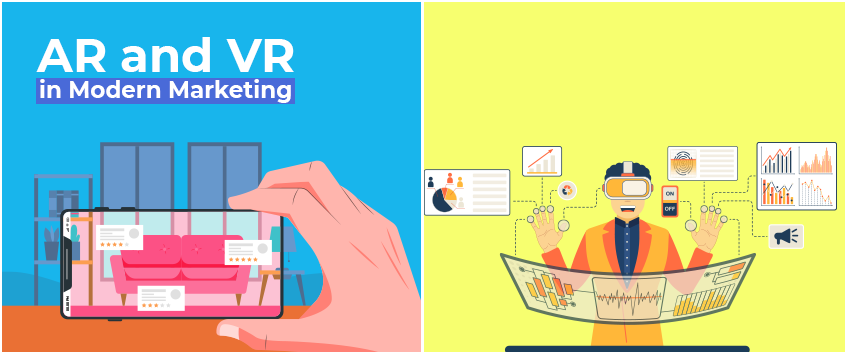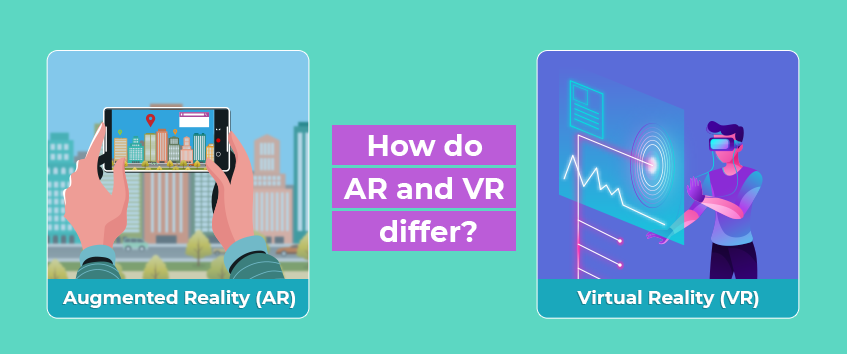Revolutionizing Engagement: The Power of AR and VR in Modern Marketing
April 22, 2024
In today’s digital-first landscape, the significance of technological innovation in shaping marketing strategies cannot be overstated. Augmented Reality (AR) and Virtual Reality (VR) are at the forefront of this revolution, fundamentally altering the ways brands interact with their consumers. These technologies are not mere trends that will fade into the backdrop of digital evolution; rather, they represent a foundational shift that is set to redefine the interaction between consumers and brands across various sectors. This blog aims to explore the transformative role of AR and VR in revolutionizing retail experiences, virtual try-ons, interactive advertising, and enhancing the online shopping journey, especially for a digital marketing agency based in Kochi, where the fusion of technology and marketing is increasingly becoming a necessity.
As the digital marketing landscape becomes more competitive, businesses are continually seeking innovative ways to captivate their audiences. AR and VR technologies have emerged as powerful tools in this quest, offering immersive experiences that transcend traditional advertising and online shopping. In the realm of retail, these technologies are creating unparalleled opportunities for engagement. AR enables customers to visualize products in real-time, in their own space, thereby reducing the gap between digital exploration and physical experience. For instance, furniture retailers are using AR to allow customers to see how a piece of furniture would look in their room before making a purchase decision. This not only enhances customer satisfaction but also significantly reduces the likelihood of returns.
VR takes this immersive experience a step further by allowing customers to navigate through virtual stores or environments from the comfort of their homes. This technology is particularly beneficial in today’s context, where safety and convenience are paramount. Customers can virtually try on clothes, accessories, or even makeup, providing them with a realistic preview of the products. Such virtual try-ons are not just a novelty; they represent a new frontier in personalized shopping experiences, enabling brands to offer tailor-made recommendations based on customer preferences and previous interactions.
Interactive advertising, powered by AR and VR, is reshaping the way brands engage with their audience. Traditional ads, often seen as intrusive, are being transformed into engaging, interactive experiences that consumers look forward to. Through AR filters on social media platforms or VR experiences at events, brands are creating memorable moments that foster a deeper connection with their audience. These interactive experiences are not only more engaging but also more likely to be shared, amplifying the brand’s reach and impact.
Elevating the online shopping journey through AR and VR technologies has become a strategic priority for brands aiming to thrive in the digital age. By providing immersive, interactive, and personalized experiences, these technologies help bridge the gap between online and offline shopping. They offer a glimpse into the future of retail—a future where digital and physical realms merge to create a seamless, engaging shopping experience.
For a digital marketing agency in Kochi, embracing AR and VR technologies is not just about staying ahead of the curve; it’s about redefining the curve. As these technologies continue to evolve, their potential to transform marketing strategies and create meaningful, engaging consumer experiences is limitless. By leveraging AR and VR, brands can not only connect with their audience in innovative ways but also drive forward the digital revolution in marketing. In an era where differentiation is key, AR and VR technologies offer a unique opportunity for brands to stand out, delivering experiences that are as impactful as they are unforgettable.
Immersive Retail Experiences: Bridging Digital and Physical Worlds
The evolution of the retail sector is being propelled into a new era by the advent of AR and VR technologies. These innovations are redefining the boundaries between online and offline shopping, offering customers immersive experiences that were once the realm of science fiction. This digital transformation is enabling retailers to blend the convenience of online shopping with the tangibility of physical store experiences, creating a seamless hybrid that caters to the modern consumer’s demands for efficiency and engagement.
Navigating the Virtual Aisles
Virtual Reality is at the forefront of this retail revolution. By donning a VR headset, consumers are transported into a digital store that mimics the layout and experience of a physical retail space. These VR setups offer a level of interactivity and realism that goes beyond simple online shopping. Shoppers can “walk” through aisles, pick up products, examine them in 3D, and read detailed information just as they would in a real store. Some platforms even feature virtual sales assistants, capable of answering questions and providing recommendations through AI technology. This immersive experience not only makes shopping more engaging but also allows customers to make informed decisions from the comfort of their homes, effectively bridging the gap between digital convenience and the physical shopping experience.
Augmenting Reality for Customized Shopping
Augmented Reality takes a slightly different approach by overlaying digital information onto the real world, enhancing but not replacing the physical environment. Retail applications of AR technology are particularly impactful in the home goods sector. Customers can use their smartphones or tablets to see how a piece of furniture or decor would look in their actual living spaces. This functionality extends beyond mere visualization; it allows for customization in colour, size, and design, providing a personalized shopping experience that traditional online platforms cannot offer. By leveraging AR, retailers give customers the tools to design their living spaces in real-time, ensuring that what they purchase will indeed fit their home’s aesthetic and spatial requirements.
The Fusion of Convenience and Personalization
The integration of AR and VR technologies into the retail sector signifies a significant leap towards a more dynamic, personalized, and convenient shopping experience. These technologies not only cater to the consumer’s desire for efficient online shopping options but also address the need for tangible, interactive experiences akin to those of physical stores. As digital marketing strategists in Kerala look towards the future, the emphasis will be on leveraging these immersive technologies to create a seamless blend of digital and physical worlds. This hybrid model not only enhances customer satisfaction and loyalty but also positions brands at the cutting edge of retail innovation. In this rapidly evolving landscape, the ability to offer immersive, customized shopping experiences will be a key differentiator for retailers aiming to thrive in the digital age.
Interactive Advertising: Captivating Audiences with Innovation

In the ever-evolving world of digital marketing, the quest to capture consumer attention has led brands to continually seek innovative strategies. The integration of AR and VR technologies into advertising campaigns represents a seismic shift in how brands interact with their audiences. These technologies are not just embellishments to the traditional advertising model but are redefining the very essence of interactive marketing. By transforming passive viewers into active participants, AR and VR are setting new standards for engagement and immersion in the advertising domain.
The Magic of AR in Advertising
Augmented Reality, in particular, has found a unique niche in interactive advertising. By overlaying digital content onto the real world through the lens of a smartphone or tablet, AR turns everyday environments into dynamic spaces of discovery and engagement. For instance, pointing your device at a static movie poster can bring it to life, playing the movie’s trailer in augmented space. This ability to animate the physical world with digital content adds a layer of depth and interaction that traditional mediums struggle to achieve.
Imagine walking through a city street, your phone acting as a lens that reveals hidden stories, exclusive offers, or interactive games related to nearby products or services. This not only captivates the user’s attention in a crowded advertising space but also fosters a deeper connection between the brand and its audience. The novelty and engagement offered by AR can significantly enhance recall and brand loyalty, making it a powerful tool in a marketer’s arsenal.
VR: Immersing Consumers in Brand Stories

While AR enhances the world around us, Virtual Reality offers an escape to entirely new ones. VR advertising is about creating immersive environments where users can experience a brand’s products or services in a fully controlled setting. From test-driving a car on a virtual racetrack to exploring a holiday resort before booking a vacation, VR can transport consumers to places and experiences that physical or other digital advertisements cannot.
This immersive approach does more than just capture attention; it engages emotions, creating memorable experiences that consumers associate with the brand. By leveraging VR, marketers can craft compelling narratives that invite consumers to step into their brand story, engage with it, and ultimately form a deeper, more emotional connection with the brand.
Crafting Memorable Experiences
The key to successful interactive advertising lies in creating experiences that are not only engaging but also memorable. As digital natives become increasingly desensitized to traditional advertising formats, the novelty and interactivity offered by AR and VR can break through the noise. These technologies allow brands to craft unique, immersive experiences that resonate on a personal level with their audience.
A Future Shaped by Innovation
For a digital marketing agency in Kerala, embracing AR and VR technologies represents a forward-thinking approach to advertising that aligns with consumer trends towards more interactive and immersive content. As these technologies continue to evolve and become more accessible, their potential to transform the advertising landscape is limitless. Interactive advertising powered by AR and VR is not just about showcasing innovation; it’s about creating a deeper, more engaging dialogue with consumers. By integrating these technologies into their advertising strategies, brands can not only capture the fleeting attention of their audiences but also forge lasting connections that propel them into the future of digital marketing.
Elevating Online Shopping: The Seamless Integration of AR and VR
The digital transformation of retail through AR and VR is revolutionizing the e-commerce landscape, ushering in an era of enriched and seamless online shopping experiences. This technological evolution extends beyond mere transactions to offer consumers immersive previews and interactions with products, significantly enhancing the decision-making process. For a performance marketing agency in Kerala, understanding and leveraging these advancements can unlock unprecedented opportunities for brand growth and customer engagement on a global scale. 
Transforming Decision-Making with AR
AR technology has become a game-changer for online shopping, offering a bridge between the tangible and digital worlds. Through AR, consumers can visualize products in their real-life environment, whether it’s seeing how a piece of furniture fits in their room or how a pair of sunglasses looks on their face. This level of interaction provides a more informed shopping experience, reducing uncertainty and the likelihood of returns. AR’s ability to provide realistic product previews and sizing information empowers customers to make purchases with confidence, enhancing satisfaction and loyalty.
Immersive Experiences with VR
Virtual Reality takes the online shopping experience to another dimension, creating fully immersive environments where consumers can engage with products and brands in ways previously limited to physical locations. VR platforms can host virtual pop-up shops, fashion shows, or even product launches, offering exclusive content and experiences. These virtual events not only provide unique opportunities for engagement but also break down geographical barriers, allowing global audiences to participate in brand experiences from anywhere in the world. By offering these novel experiences, brands can captivate and maintain consumer interest in a crowded digital marketplace.
Seamless Integration for a Future-Ready Retail
The seamless integration of AR and VR into online shopping platforms is not merely a trend but a significant shift towards creating more interactive and personalized shopping journeys. This integration allows for a blend of convenience and experiential engagement that traditional online platforms cannot replicate on their own. As consumers increasingly seek more from their online shopping experiences, AR and VR technologies offer the tools to meet these demands, providing a competitive edge for brands willing to invest in these innovations.
Unlocking New Avenues for Engagement and Reach
The potential of AR and VR in online shopping extends beyond enhancing the consumer experience; it also opens up new avenues for global brand reach and engagement. By transcending physical and geographical limitations, brands can engage with a wider audience, offering personalized and immersive experiences that resonate on a global scale. This increased reach is not just about sales but about building a more robust and interactive brand presence in the digital world. 
The integration of AR and VR technologies into online shopping represents a paradigm shift in how consumers interact with brands and make purchasing decisions. For a digital marketing agency in Kerala, harnessing these technologies can elevate client strategies, creating unparalleled customer experiences that drive engagement, satisfaction, and loyalty. As the digital landscape continues to evolve, the brands that will thrive are those that embrace these innovations, offering their customers not just products, but memorable and engaging experiences. In this new era of online shopping, AR and VR are not just tools but essential components of a future-ready retail strategy.
A New Dimension of Marketing
The landscape of digital marketing is undergoing a transformative shift with the integration of AR and VR, heralding a new era of consumer engagement. These technologies are not merely additions to the marketer’s toolkit but are reshaping the foundation of marketing strategies, offering unparalleled opportunities for interactive, personalized, and engaging experiences. As AR and VR evolve and become increasingly accessible, they are blurring the boundaries between the digital and physical worlds, enhancing every aspect of the consumer journey.
The promise of AR and VR in marketing is to transform passive interactions into immersive explorations, making every touchpoint an opportunity for discovery. This evolution signifies a move towards more meaningful and memorable connections between brands and their audiences. By leveraging the immersive capabilities of AR and VR, marketers can create experiences that captivate, educate, and inspire, setting a new standard for customer engagement.

For a digital marketing agency in Kerala, embracing these cutting-edge technologies represents a forward-thinking approach to crafting compelling narratives and experiences that resonate with a global audience. As we look towards the future, the integration of AR and VR into marketing strategies is not just an option but a necessity for brands seeking to thrive in an increasingly competitive landscape. This new dimension of marketing is about more than just innovation; it’s about creating a deeper, more connected world where every interaction is an opportunity for engagement and exploration.
